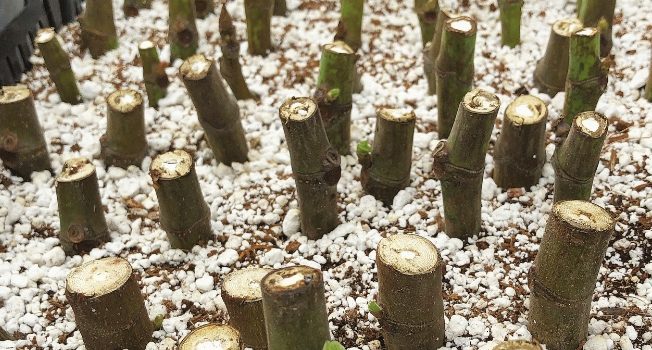
Rooting Dormant Hardwood Fig Cuttings
There are few activities more rewarding to a gardener than being able to propagate their own plants. While vegetable gardeners throughout the world commonly propagate plants by germinating seeds, the subtle art of propagating woody plants via rooted cuttings brings its own unique challenges and joys.
Figs are one of the first woody plants many gardeners try to propagate via cuttings due to their ease of rooting and rapid, vigorous growth when young. Most varieties root very quickly, usually in about 3 weeks, making figs the gateway plant for many to the enchanting world of woody plant propagation.
There are nearly as many methods for rooting figs as there are varieties and we’ve experimented with many over the years. From rooting cuttings in plastic Ziplock bags when we’re on the road, to climate controlled greenhouses with bottom heat and mist, you can get figs and other plants to root using many different methods and you don’t need a professional greenhouse to do it.
First, be sure to collect vigorous healthy cuttings from the previous season’s growth. Dormant cuttings can be taken any time of year between late October and February. Many growers attest that fig cuttings taken in the fall have more sap in them and therefore root more easily but we’ve never noticed much of a difference. And while it’s typically easier to root dormant cuttings we’ve had success rooting hardwood and softwood cuttings at just about any time of the year. Wood taken from near the base or where they are touching the soil or mulch line typically root more easily and sometimes already have roots forming.
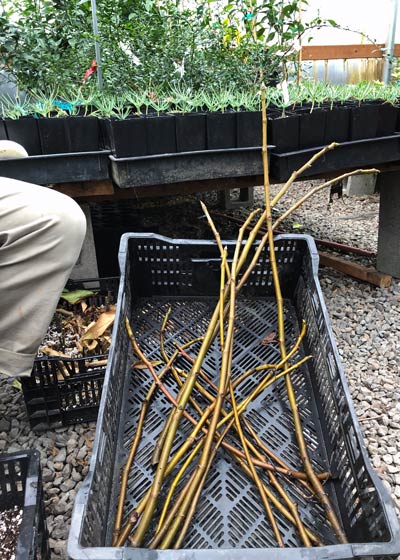
We’ve also noticed that wild fig seedlings we’ve collected, root particularly fast and are exceptionally vigorous. So keep an eye out for those when driving through the land of the fig wasp!
Once you’ve collected your cuttings you can cut them into the appropriate sizes for rooting them. Too large of cuttings will not be able to sustain all the leaves that are produced and too small of cuttings lack vigor. Typically we go for cuttings that have at least 2 nodes on them and are around 4-6 inches long.
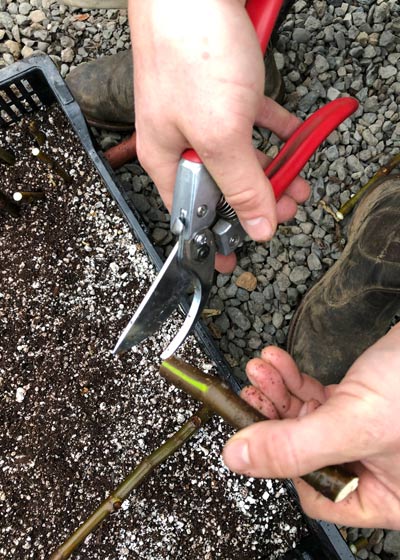
For the media you’ll be placing the cuttings in, there are many options. The most important thing is to be sure that it has no fertilizer or nutrients! While it’s certainly possible to root cuttings in potting soil or a rich compost, your success rate will go down dramatically. The young cuttings need a completely sterile mix as they don’t yet have any roots and therefore can’t take up the nutrients in a charged soil. The nitrogen will cause them to rot and when rooting cuttings the difference between rotting and rooting makes all the difference.
Our preferred media is a washed coconut coir and perlite, with a ratio of around 30-40% coconut coir to 60-70% perlite. The coconut coir retains moisture while the perlite provides aeration and keeps the media from going anaerobic. For figs we go slightly heavy on the perlite as they are prone to rotting if the media stays too moist. The most common cause of failure with fig cuttings, or cuttings of many other species, is keeping the media too moist. If the cuttings have not calloused over yet this can cause them to rot.
We always err on the side of keeping figs more dry rather than too wet. They aren’t actively taking up water during the rooting process so the rooting media is really only there to provide humidity so the cutting doesn’t desiccate before it can make roots. Using the plastic bag with a moist paper towel method has also proven successful when we’re rooting figs abroad or on the road because what’s most important is keeping the cutting humid.
Once you’ve cut your branches into 4-6 inch cuttings you can scrape a thin layer of bark away at the bottom of the cutting exposing the bright green cambium layer beneath. While some species such as olives root primarily out of the nodes figs seem to root from just about everywhere, with heavy rooting occurring along the internodes.
Rooting hormone is not completely necessary with most varieties of figs. Their natural propensity to root is so strong that we’ve seen no difference in figs rooted with or without hormone. If you do want to use hormone we suggest a low strength hormone.
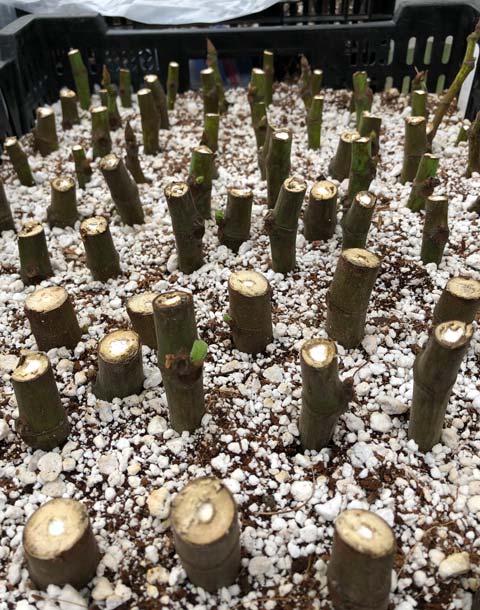
We space our cuttings about an inch and a half or two inches apart and buried about half to two thirds of their length in the media. Once all your cuttings are set you can place it on a heating mat or in a warm space. We’ve heard of some folks using the top of their refrigerator to root cuttings as it gives off some heat, but anywhere that stays around 75-80 degrees will work.
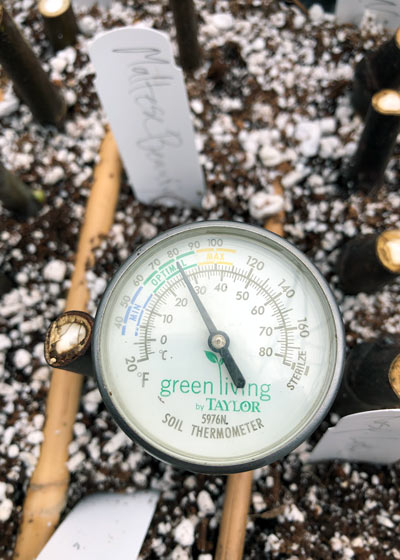
Warmth and humidity are the key factors to successfully rooting your fig cuttings. Because we’re taking dormant hardwood cuttings in this case they don’t even require light until they begin producing leaves. A simple soil thermometer can help you keep your cuttings at the ideal temperature. Using a plastic covering over your cuttings can also help maintain high levels of humidity as can occasional misting.
In about a month you should start to see buds opening, but don’t get impatient or too excited and pot them up too soon! Figs are prone to collapsing if potted up too early. We typically wait two months before potting them up, but if they’re pushing active vigorous shoots then you can be pretty sure they’re sufficiently rooted and pot them up into a lightly charged potting media.
Before you know it you’ll be supplying your entire neighborhood and all your friends with young fig trees! Perhaps the vacant lot on the corner or the empty parking strip on the way to your favorite restaurant or grocery store could use a guerrilla planted fig tree. Or maybe you’ve found a fig tree growing in your neighborhood that you just have to have and the only way to be sure you get that exact variety is to root it yourself. But for the love of figs please do not give them a new varietal name to add to the confusion of the already infinite number of fig synonyms. The common practice for naming an unknown variety is to name it by where it’s found and include “Unk.” at the end of the name for unknown.
And if learning by watching a video is more your style we posted one here.
